NCERT Solutions for Chapter 7 Triangles Class 9 Maths
Book Solutions1
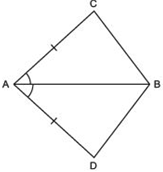
Answer
In quadrilateral ABCD we have AC = ADand AB being the bisector of ∠A.
Now, in ΔABC and ΔABD,

AC = AD [Given]
AB = AB [Common]
∠CAB = ∠DAB [∵ AB bisects ∠ CAD]
∴ Using SAS criteria, we have ΔABC ≌ ΔABD.
∵ Corresponding parts of congruent triangles (c.p.c.t) are equal.
∴ BC = BD.
2
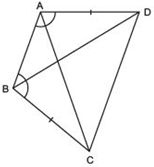
(i) ΔABD ≅ ΔBAC
(ii) BD = AC
(iii) ΔABD ≅ ΔBAC.
Answer
In quadrilateral ABCD, we have AD = BC and ∠DAB = ∠CBA.
In ΔABD and ΔBAC,
(i) AD = BC [Given]
AB = BA [Common]
∠DAB = ∠CBA [Given]
∴ Using SAS criteria, we have ΔABD ≌ ΔBAC
(ii) ∵ ΔABD ≌ ΔBAC
∴ Their corresponding parts are equal.
⇒ BD = AC
(iii) Since ΔABD ≌ ΔBAC
∴ Their corresponding parts are equal.
⇒ ΔABD ≅ ΔBAC.
3
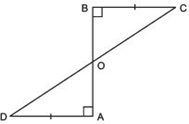
Answer
We have ∠ABC = 90° and ∠BAD = 90°Also AB and CD intersect at O.
∴ Vertically opposite angles are equal.
Now, in ΔOBC and ΔOAD, we have

∠ABC = ∠BAD [each = 90°]
BC = AD [Given]
∠BOC = ∠AOD [vertically opposite angles]
∴ Using ASA criteria, we have ΔOBC ≌ ΔOAD
⇒ OB = OA [c.p.c.t.]
i.e. O is the mid-point of AB Thus, CD bisects AB.
4
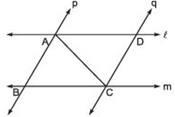
Answer
∵ ℓ || m and AC is a transversal,∴ ∠BAC = ∠DCA [Alternate interior angles]
Also p || q and AC is a transversal,
∴ ∠BCA = ∠DAC [Alternate interior angles]
Now, in ΔABC and ΔCDA,
∠BAC = ∠DCA [Proved]
∠BCA = ∠DAC [Proved]
CA = AC [Common]
∴ Using ASA criteria, we have ΔABC ≌ ΔCDA
5
(i) ΔAPB ≅ ΔAQB
(ii) BP = BQ or B is equidistant from the arms of ∠ A.
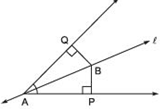
Answer
(i) We have, ℓ as the bisector of QAP.
∴ ∠QAB = ∠PAB
∠Q= ∠P [each = 90°]
⇒ ∠ABQ = ∠ABP [Two angles of trinagles are equal then third will also be equal]
Now, in ΔAPB and ΔAQB, we have
AB = AB [common]
∠ABP = ∠ABQ [proved]
∠PAB = ∠QAB [proved]
∴ Using SAS criteria, we have ΔAPB ≌ ΔAQB
(ii) Since ΔAPB ≌ ΔAQB
∴ Their corresponding angles are equal.
⇒ BP = BQ
i.e. [Perpendicular distance of B from AP] = [Perpendicular distance of B from AQ]
Thus, the point B is equidistant from the arms of ∠A.
6

Answer
We have ∠BAD = ∠EACAdding ∠DAC on both sides, we have
∠BAD + ∠DAC = ∠EAC + ∠DAC
⇒ ∠BAC = ∠DAE
Now, in ΔABC and ΔADE, we have
∠BAC = ∠DAE [Proved]
AB = AD [Given]
AC = AE [Given]
∴ ΔABC ≌ ΔADE [Using SAS criteria]
Since ΔABC ≌ ΔADE, therefore, their corresponding parts are equal.
⇒ BC = DE.
7
(i) ΔDAP ≅ ΔEBP
(ii) AD = BE
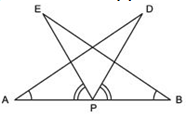
Answer
We have, P is the mid-point of AB.
∴ AP = BP
∠EPA = ∠DPB [Given]
Adding ∠EPD on both sides, we get
∠EPA + ∠EPD = ∠DPB + ∠EPD
⇒ APD = ∠BPE
(i) Now, in ΔDAP ≌ ΔEBP, we have
AP = BP [Proved]
∠PAD = ∠PBE [∵ It is given that ∠BAD = ∠ABE]
∠DPA = ∠EPB [Proved]
∴ Using ASA criteria, we have
ΔDAP ≌ΔEBP
(ii) Since, ΔDAP ≌ΔEBP
∴ Their corresponding parts are equal. ⇒ AD = BE.
8
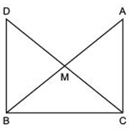
(i) ΔAMC ≅ΔBMD
(ii) ∠DBC is a right angle.
(iii) ΔDBC ≅ ΔACB
(iv) CM = (1/2)AB
Answer
∵ M is the mid-point of AB.
∴ BM = AM [Given]
(i) In ΔAMC and ΔBMD, we have CM = DM [Given]
AM = BM [Proved]
∠AMC = ∠BMD [Vertically opposite angles]
∴ ΔAMC ≌ ΔBMD (SAS criteria)
(ii) ∵ ΔAMC ≌ ΔBMD
∴ Their corresponding parts are equal.
⇒ ∠MAC = ∠MBD But they form a pair of alternate interior angles.
∴ AC || DB
Now, BC is a transversal which intersecting parallel lines AC and DB,
∴ ∠BCA + ∠DBC = 180°
But ∠BCA = 90 [∵ ΔABC is right angled at C]
∴ 90° + ∠DBC = 180°
or ∠DBC = 180° ∠ 90° = 90°
Thus, ∠DBC = 90°
(iii) Again, ΔAMC ≌ ΔBMD [Proved]
∴ AC = BD [c.p.c.t]
Now, in ΔDBC and ΔACB, we have
∠DBC = ∠ACB [Each = 90°]
BD = CA [Proved]
BC = CB [Common]
∴ Using SAS criteria, we have ΔDBC ≌ ΔACB
(iv) ∵ ΔDBC ≌ ΔACB
∴ Their corresponding parts are equal.
⇒ DC = AB
But DM = CM [Given]
∴ CM = (1/2) DC = (1/2) AB
⇒ CM = (1/2) AB
1
(i) OB = OC
(ii) AO bisects ∠A
Answer
(i) In ΔABC, we have AB = AC [Given]
∴ ∠C= ∠B [Angle opposite to equal sides are equal]
⇒ (1/2)∠C= (1/2)∠B
or ∠OCB = ∠OBC
⇒ OB = OC [Sides opposite to equal angles are equal]
(ii) In ΔABO and ΔACO, we have
AB = AC [Given]
OB = OC [Proved]
∠OBA = ∠OCA [(1/2)∠B = (1/2)∠C ]
∴ Using SAS criteria,
ΔABO ≌ ΔACO
⇒ ∠OAB = ∠OAC [c.p.c.t.]
⇒ AO bisects ∠A.
2
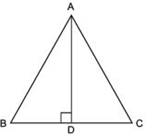
Answer
∵ AD is bisector of BC.∴ BD = CD
Now, in ΔABD and ΔACD, we have:
AD = AD [Common]
∠ADB = ∠ADC = 90° [∵ AD ⊥ BC]
BD = CD [Proved]
∴ ΔABD ≌ ΔACD [SAS criteria]

∴ Their corresponding parts are equal.
⇒ AB = AC Thus, ΔABC is an isosceles triangle.
3
OR
ABC is an isosceles triangle with AB = AC. Prove that the altitudes BE and CF of the triangle are equal.
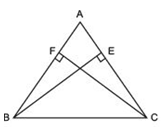
Answer
ΔABC is an isosceles triangle.∴ AB = AC
⇒ ∠ACB = ∠ABC [∵ Angles opposite to equal sides are equal]
Now, in ΔBEC and ΔCFB, we have
∠EBC = ∠FCB [Proved]
BC = CB [Common]
and ∠BEC = ∠CFB [Each = 90°]
∴ ΔBEC ≌ ΔCFB [Using ASA criteria]
⇒ Their corresponding parts are equal. i.e. BE = CF
4
(i) ΔABE ≌ ΔACF
(ii) AB = AC, i.e. ABC is an isosceles triangle.
Answer
(i) In ΔABE and ΔACF, we have
∠AEB = ∠AFC [each = 90° ∵ BE ⊥ AC and CF ⊥ AB]
∠A= ∠A [Common]
BE = CF [Given]
∴ ΔABE ≌ ΔACF [Using AAS criterion]
(ii) Since, ΔABE ≌ ΔACF
∴ Their corresponding parts are equal.
⇒ AB = AC
5
Answer
In ΔABC, we have AB = AC [∵DABC is an isosceles triangle]
But angles opposite to equal sides are equal.
∴ ∠ABC = ∠ACB ...(1)
Again, in ΔBDC, we have BD = CD
[∵ΔBDC is an isosceles triangle.]
∴ ∠CBD = ∠BCD ...(2)
[Angles opposite to equal sides are equal]
Adding (1) and (2), we have
∠ABC + ∠CBD = ∠ACB + ∠BCD
⇒ ∠ABD = ∠ACD
6

Answer
∵ In ΔABC, AB = AC [Given] …(1)
AB = AD [Given] …(2)
From (1) and (2), we have AC = AD
Now, in ΔABC, we have ∠B + ∠ACB + ∠BAC = 180°
⇒ 2∠ACB + ∠BAC = 180° …(3)
[∵ ∠B = ∠ACB (Angles opposite to equal sides)]
In ΔACD, ∠D + ∠ACD + ∠CAD = 180°
⇒ 2∠ACD + ∠CAD = 180° ...(4)
[∵∠D = ∠ACD (angles opposite to equal sides)]
Adding (3) and (4), we have
2∠ACB + ∠BAC + 2∠ACD + ∠CAD = 180° + 180°
⇒ 2[∠ACB + ∠ACD] + [∠BAC + ∠CAD] = 360°
⇒ 2[∠BCD] + [180°] = 360° [∠BAC and ∠CAD form a linear pair]
⇒ 2∠BCD = 360°
⇒ ∠BCD = (180°/2)= 90°
Thus, ∠BCD = 90°.
7
Answer
In ΔABC, we have AB = AC [Given]
∴ Their opposite angles are equal.
⇒ ∠ACB = ∠ABC
Now, ∠A + ∠B + ∠C = 180°
⇒ 90° + ∠B + ∠C = 180° [∵ ∠A = 90° (Given)]
⇒ ∠B + ∠C = 180°
But ∠ABC = ∠ACB,
i.e. ∠B = ∠C
∴ ∠B= ∠C = (90°/2) = 45°
Thus, ∠B = 45° and ∠C = 45°
8
Answer
In ΔABC, we have
AB = BC = CA [∵ ABC is an equilateral triangle]
∴ AB = BC ⇒ ∠A = ∠C …(1)
[∵ Angle opposite to equal sides are equal.]
Similarly, AC = BC ⇒ ∠A = ∠B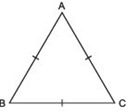
From (1) and (2), we have ∠A= ∠B = ∠C
Let ∠A= ∠B = ∠C = x
Since, ∠A + ∠B + ∠C = 180°
∴ x + x + x = 180°
⇒ 3x = 180° or x =(180°/3) = 60°
∴ ∠A= ∠B = ∠C = 60°
Thus, the angles of an equilateral triangle are 60° each.
1
If AD is extended to intersect BC at P, show that
(i) ΔABD ≌ ΔACD
(ii) ΔABP ≌ ΔACP
(iii) AP bisects ∠ A as well as ∠ D.
(iv) AP is the perpendicular bisector of BC.
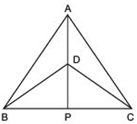
Answer
(i) In ΔABD and ΔACD, we have
AB = AC [Given]
AD = AD [Common]
BD = CD [Given]
∴ ΔABD ≌ ΔACD [SSS Criteria]
(ii) In ΔABP and ΔACP, we have
AB = AC [Given]
∴ AB = AC
⇒ ∠B = ∠C [∵Angle opposite to equal sides are equal]
AP = AP [Common]
∴ ΔABP ≌ ΔACP [SAS Criteria]
(iii) Since, ΔABP ≌ ΔACP
∴ Their corresponding parts are congruent.
⇒ ∠BAP = ∠CAP
∴ AP is the bisector of ∠A ...(1)
Again, in ΔBDP and ΔCDP, we have
BD = CD [Given]
∠DBP = ∠CDP [Angles opposite to equal sides]
DP = DP [Common]
⇒ ∠BDP ≌ ∠CDP
∴ ∠BDP = ∠CDP [c.p.c.t.]
⇒ DP (or AP) is the bisector of ∠D ...(2)
From (1) and (2), AP is the bisector of ∠A as well as ∠D.
(iv) ∵ ΔABP ≌ ΔACP
∴ Their corresponding parts are equal.
⇒ ∠APB = ∠APC
But ∠APB + ∠APC = 180º [Linear pair]
∴ ∠APB = ∠APC = 90º
⇒ AP ⊥ BC
⇒ AP is the perpendicular bisector of BC
2
(i) AD bisects BC
(ii) AD bisects ∠A
Answer
(i) In ΔABD and ΔACD, we have
AB = AC [Given]
∠B= ∠C [Angles opposite to equal sides]
AD = AD [Common]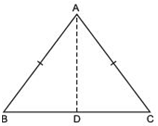
∴ ΔABD ≌ ΔACD
⇒ Their corresponding parts are equal.
∴ BD = CD
⇒ D is the mid-point of BC or AD bisects BC.
(ii) Since, ΔABD ≌ ΔACD,
∴ Their corresponding parts are congruent.
⇒ ∠BAD = ∠CAD
⇒ AD bisects ∠A.
3
Two sides AB and BC and median AM of one triangle ABC are respectively equal to sides PQ and QR and median PN of ΔPQR (see figure). Show that
(i) ΔABM ≌ ΔPQN
(ii) ΔABC ≌ ΔPQR
Answer
In ΔABC, AM is a median [Given].
∴ BM = (1/2)BC …(1)
In ΔPQR, PN is a median.
∴ QN = (1/2)QR …(2)
∵ BC = QR [Given]
∴ (1/2)BC = (1/2)QR
⇒ BM = QN [From (1) and (2)]
(i) In ΔABM and ΔPQN, we have
∵ AB = PQ [Given]
AM = PN [Given]
BM = QN [Proved]
∴ ΔABM ≌ ΔPQN [SSS criteria]
(ii) ∵ ΔABM ≌ ΔPQN
∴ Their corresponding parts are congruent.
⇒ ∠B= ∠Q
Now, in ΔABC and ΔPQR, we have
∠B= ∠Q [Proved]
AB = PQ [Given]
BC = QR [Given]
∴ ΔABC ≌ ΔPQR
4
Answer
∵ BE ⊥ AC [Given]∴ ΔBEC is a right triangle such that ∠BEC = 90º
Similarly, ∠CFB = 90º
Now, in right ΔBEC and right ΔCFB, we have
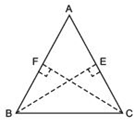
BE = CF [Given]
BC = CB [common]
∴ Using RHS criteria,
ΔBEC ≌ ΔCFB
∴ Their corresponding parts are equal.
⇒ ∠BCE = ∠CBF or ∠BCA = ∠CBA
Now, in ΔABC, ∠BCA = ∠CBA
∴ Their opposite sides are equal.
⇒ AB = AC
∴ ΔABC is an isosceles triangle.
5
Answer
We have AP ⊥ BC [Given]∴ ∠APB = 90º and APC = 90º
In ΔABP and ΔACP, we have
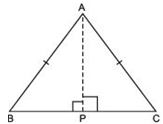
∠APB = ∠APC [each = 90º]
AB = AC [Given]
AP = AP [common]
∴ Using RHS criteria,
ΔABP ≌ ΔACP
∴ Their corresponding parts are congruent.
⇒ ∠B= ∠C
1
Answer
Let us consider ΔABC such that ∠B = 90º∴ ∠A + ∠B + ∠C = 180º
∴ [∠A + ∠C] + ∠B = 180º
⇒ ∠A + ∠C = 90º
⇒ ∠A + ∠C= ∠B
∴ ∠B > ∠A and ∠B > ∠C

⇒ Side opposite to ∠B is longer than the side opposite to ∠A.
i.e. AC > BC ...(1)
Similarly, AC > AB ...(2)
From (1) and (2), we get AC is the longest side.
But AC is the hypotenuse of the triangle.
Thus, hypotenuse is the longest side.
2
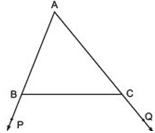
Answer
∠ABC + ∠PBC = 180º [Linear pair]
and ∠ACB + ∠QCB = 180º [Linear pair]
∴ ∠ABC + ∠PBC = ∠ACB + ∠QCB
But ∠PBC < ∠QCB [Given]
∴ ∠ABC > ∠ACB
⇒ [The side opposite to ∠ABC] > [The side opposite to ∠ACB]
⇒ AC > AB
3
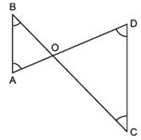
Answer
∵ ∠B< ∠A [Given]⇒ ∠A> ∠B
∴ OB > OA ...(1)
[Side opposite to greater angle is longer]

Similarly, OC > OD ...(2)
From (1) and (2), we have
[OB + OC] > [OA + OD]
⇒ BC > AD or AD < BC
4
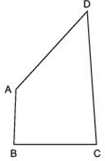
Answer
Let us join AC.
Now, in ΔABC, AB < BC [∵ AB is the smallest side of quadrilateral ABCD]
⇒ BC > AB
∴ [Angle opposite to BC] < [Angle opposite to AB]
⇒ ∠BAC > ∠BCA ...(1)
Again, in ΔACD,
CD > AD [∵ CD is the longest side of the quadrilateral ABCD]
∴ [Angle opposite to CD] > [Angle opposite to AD]
⇒ ∠CAD > ∠ACD ...(2)
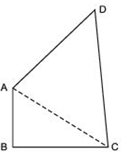
Adding (1) and (2), we get
[∠BAC + CAD] > [∠BCA + ∠ACD]
⇒ ∠A> ∠C
Similarly, by joining BD, we have ∠B> ∠D
5
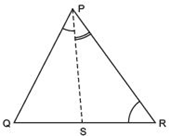
Answer
In ΔPQR, PS bisects ∠QPR [Given]∴ ∠QPS = ∠RPS
∵ PR > PQ [Given]

∴ [Angle opposite to PR] > [Angle opposite to PQ]
⇒ ∠PQS > ∠PRS
⇒ [∠PQS + ∠QPS] > [∠PRS + ∠RPS] ...(1)
[∵ ∠QPS = ∠RPS]
∵ Exterior ∠PSR = [∠PQS + ∠QPS]
[∵ An exterior angle is equal to the sum of interior opposite angles]
and Exterior ∠PSQ = [∠PRS + ∠RPS]
Now, from (1), we have ∠PSR > ∠PSQ
6
Answer
Let us consider the ΔPMN such that ∠M = 90ºSince, ∠M + ∠N + ∠P = 180º

[Sum of angles of a triangle] ∵
∠M = 90º [∵ PM ⊥ ℓ]
⇒ ∠N< ∠M ⇒ PM < PN ...(1)
Similarly, PM < PN1 ...(2)
PM < PN2 ...(3)
From (1), (2) and (3), we have PM is the smallest line segment drawn from P on the line l.
Thus, the perpendicular segment is the shortest line segment drawn on a line from a point not on it.
1
Answer
Let us consider a ΔABC.Draw ‘l’ the perpendicular bisector of AB.
Draw ‘m’ the perpendicular bisector of BC.
Let the two perpendicular bisectors ‘l’ and ‘m’ meet at O. ‘O’ is the required point which is equidistant from A, B and C.
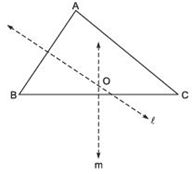
Note: If we draw a circle with centre ‘O’ and radius OB or OC, then it will pass through A, B and C.
2
Answer
Let us consider a ΔABC.Draw ‘l’ the bisector of ∠B.
Draw ‘m’ the bisector of ∠C.
Let the two bisectors l and m meet at O. Thus, ‘O’ is the required point which is equidistant from the sides of ΔABC.
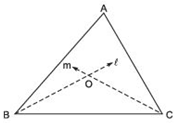
required point which is equidistant from the sides of ΔABC.
Note: If we draw OM ⊥ BC and draw a circle with O as centre and OM as radius, then the circle will touch the sides of the triangle.

3
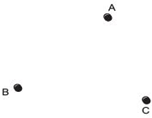
B : near which a man-made lake is situated, C: which is near to a large parking and exit.
Where should an ice cream parlour be set up so that maximum number of persons can approach it?
Hint: The parlour should be equidistant from A, B and C.
Answer
Let us join A and B, and draw ‘l’ the perpendicular bisector of AB.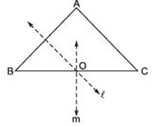
Now, join B and C, and draw ‘m’ the perpendicular bisector of BC. Let the perpendicular bisectors ‘l’ and ‘m’ meet at ‘O’. The point ‘O’ is the required point where the ice cream parlour be set up.
Note: If we join ‘A’ and ‘C’, and draw the perpendicular bisectors, then it will also meet (or pass through) the point O.
4
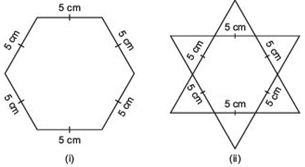
Answer
It is an activity. We get the 150 equilateral triangles in the figure(i) 300 equilateral triangles in the figure
(ii) ∴ The figure
(ii) has more triangles.